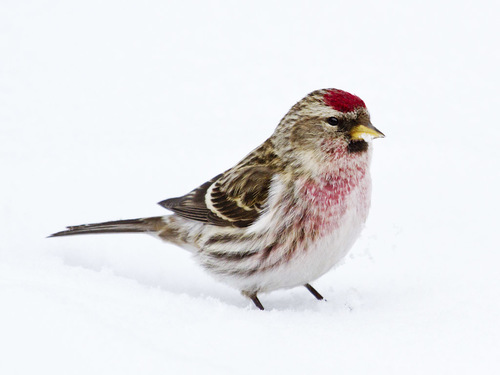
Common Redpoll
The Common Redpoll (Acanthis flammea) is a small, lively finch known for its distinctive red forehead patch and acrobatic feeding behavior. These birds are highly adapted to cold, northern climates and play an important role in seed dispersal within their boreal and tundra ecosystems. While not widely recognized in popular culture, the Common Redpoll is a favorite among birdwatchers for its energetic nature and the irruptive migrations that bring flocks to more southerly regions in some winters. Their ability to survive harsh conditions makes them a fascinating subject of study.
11.5-14 cm
Length
19-22 cm
Wingspan
Least Concern
Conservation Status
Distribution
Circumpolar distribution across the northern regions of North America, Europe, and Asia. Migratory, with some populations undertaking significant north-south movements. Breeds in the high Arctic tundra and boreal forests, and winters south to the northern United States, central Europe, and central Asia. Altitudinal range varies from sea level to subalpine zones.
Lifespan
Typically 2-3 years in the wild, up to 8 years in captivity.
Common Redpoll's Habitat
Habitat Types
Boreal forests, Tundra, Shrublands, Open woodlands, Suburban areas (during winter)
Climate Zones
Arctic, Subarctic, Temperate
Adaptations
Possesses specialized throat pouches to temporarily store seeds in harsh conditions, allowing for quicker feeding in exposed locations. Dense, fluffy plumage provides excellent insulation against extreme cold.
Variations
Several subspecies are recognized, differing slightly in size, plumage coloration, and bill morphology. Examples include *A. f. flammea* (nominate subspecies) and *A. f. rostrata* (Greenland Redpoll).
Appearance
Breeding Plumage
Breeding males develop a brighter red forehead ('poll') and pinkish wash on the breast. Non-breeding males and females are duller, with less intense red and more streaking.
Seasonal Feather Changes
Plumage becomes slightly worn and faded during the breeding season. A complete molt occurs after breeding, resulting in fresher, brighter plumage for winter.
Sex Based Plumage Differences
Males have brighter red polls and often a pinkish breast, especially during breeding season. Females are generally duller brown and streaked.
Notable Features
Red forehead patch (poll), Black chin bib, Streaked brown and buff upperparts, Two pale wingbars
Diet and Feeding
Primary Foods
Small seeds (especially birch, alder, and willow), Insects (primarily during breeding season), Buds, Catkins
Foraging Behavior
Highly acrobatic, often hanging upside down to extract seeds from cones and catkins. Forages in flocks, especially during winter. Will visit bird feeders, particularly those offering nyjer (thistle) seed.
Specializations
Throat pouches for temporary seed storage. Relatively small, pointed bill well-suited for extracting small seeds.
Seasonal Diet Variations
Diet shifts to include more insects during the breeding season to provide protein for growing chicks. Relies heavily on seeds during winter.
Behavior
Social Structure
Highly social, especially outside of the breeding season. Forms large flocks during winter, often mixed with other finch species.
Communication
Flight calls: a dry, rattling 'chif-chif-chif', Song: a series of trills and twitters, Visual displays: fluffing plumage, wing-flicking
Migration
Irruptive migrant; large numbers may move south in some winters when food resources are scarce in their usual range. Movements are often triggered by seed crop failures.
Territorial or Group Behaviors
Territorial during breeding season, defending a small area around the nest. Highly gregarious during winter, forming large foraging flocks.
Conservation
Threats
Habitat loss (due to logging, mining, and development), Climate change (altering habitat and food availability), Collisions with buildings and vehicles
Protection Programs
Monitoring of populations through bird banding and citizen science initiatives, Habitat conservation efforts in boreal and tundra regions
Local National Laws
Protected under the Migratory Bird Treaty Act in the United States and Canada.
Population Trend
Stable
Population Estimates
Global population estimated at 160,000,000 individuals.
Interesting Facts
Redpolls can survive incredibly cold temperatures.
They have been recorded surviving temperatures as low as -54°C (-65°F).
They are known for their 'irruptive' migrations.
These unpredictable movements are driven by fluctuating food supplies, leading to large numbers appearing in areas where they are not typically seen.
Common Redpolls have throat pouches.
These pouches allow them to quickly gather seeds and then retreat to a safer location to process and swallow them.
Faqs about Common Redpoll
What do Common Redpolls eat?
Primarily small seeds, especially from birch, alder, and willow trees. They also eat insects, buds, and catkins, particularly during the breeding season.
Where do Common Redpolls live?
They breed in the Arctic and subarctic regions of North America, Europe, and Asia, and winter further south in temperate zones.
Are Common Redpolls aggressive?
They can be territorial during the breeding season but are generally social and form flocks, especially in winter. They are not typically aggressive towards humans.
How can I attract Common Redpolls to my yard?
Offering nyjer (thistle) seed in feeders can attract Common Redpolls, especially during winter months.
Copyright @ Nature Style Limited. All Rights Reserved.
 English
English